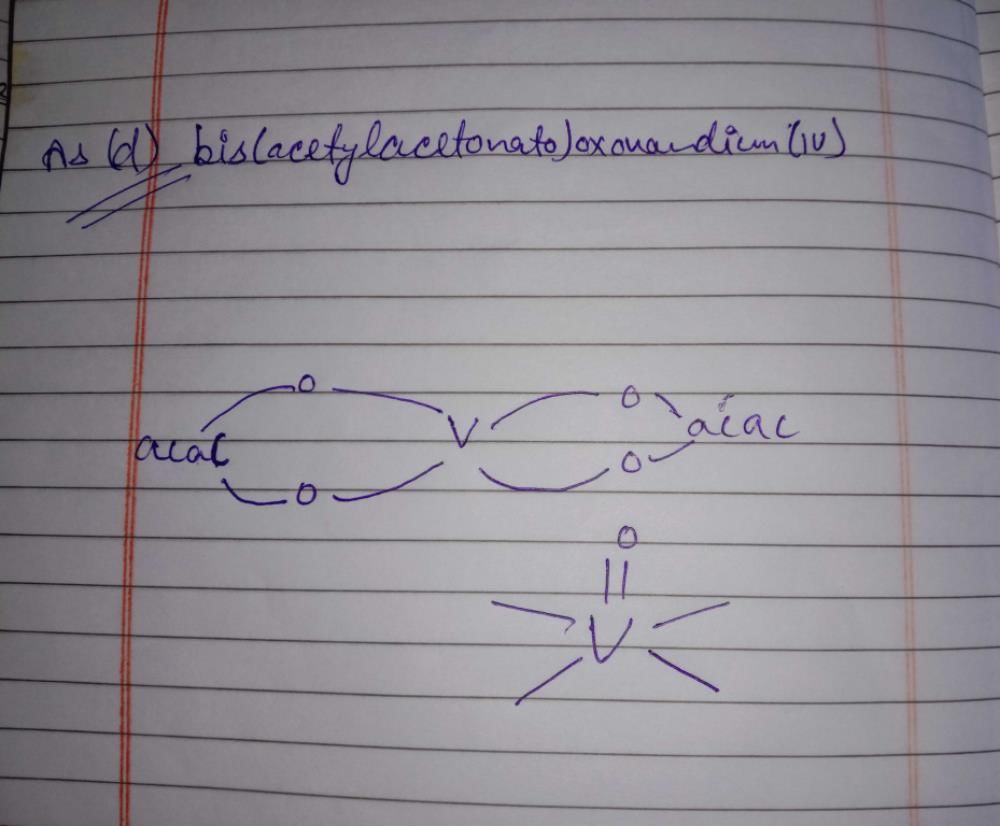Class 12 Exam > Class 12 Questions > Which among the following has square pyramida...
Start Learning for Free
Which among the following has square pyramidal geometry?
- a)Tetracarbonylnickel(0)
- b)Hexaamminecobalt(II) nitrate
- c)Pentacarbonyliron(0)
- d)Bis(acetylacetonato)oxovanadium(IV)
Correct answer is option 'D'. Can you explain this answer?
Verified Answer
Which among the following has square pyramidal geometry?a)Tetracarbony...
Bis(acetylacetonato)oxovanadium(IV) has square pyramidal geometry.
Most Upvoted Answer
Which among the following has square pyramidal geometry?a)Tetracarbony...

Free Test
FREE
| Start Free Test |
Community Answer
Which among the following has square pyramidal geometry?a)Tetracarbony...
Square pyramidal geometry is a molecular geometry in which a central atom is surrounded by five ligands arranged in a square base with one additional ligand at the apex, resulting in a pyramid-like shape. Among the given options, the compound that exhibits square pyramidal geometry is Bis(acetylacetonato)oxovanadium(IV) or option D.
Bis(acetylacetonato)oxovanadium(IV) is a coordination compound consisting of a central vanadium atom bonded to two acetylacetonate ligands (acac) and one oxo ligand (O). The acetylacetonate ligands are chelating ligands, meaning they form a ring structure with the central metal atom.
Explanation:
1. Tetracarbonylnickel(0): This compound is a coordination complex where a nickel atom is bonded to four carbonyl ligands. The geometry of this compound is square planar, not square pyramidal.
2. Hexaamminecobalt(II) nitrate: This compound consists of a central cobalt atom bonded to six ammonia ligands (NH3). The geometry of this compound is octahedral, not square pyramidal.
3. Pentacarbonyliron(0): This compound is a coordination complex where an iron atom is bonded to five carbonyl ligands. The geometry of this compound is trigonal bipyramidal, not square pyramidal.
4. Bis(acetylacetonato)oxovanadium(IV): This compound consists of a central vanadium atom bonded to two acetylacetonate ligands and one oxo ligand. The acetylacetonate ligands form a square base around the central vanadium atom, and the oxo ligand is located at the apex, resulting in a square pyramidal geometry. This compound satisfies the criteria for square pyramidal geometry.
In conclusion, among the given options, Bis(acetylacetonato)oxovanadium(IV) is the compound that exhibits square pyramidal geometry.
Bis(acetylacetonato)oxovanadium(IV) is a coordination compound consisting of a central vanadium atom bonded to two acetylacetonate ligands (acac) and one oxo ligand (O). The acetylacetonate ligands are chelating ligands, meaning they form a ring structure with the central metal atom.
Explanation:
1. Tetracarbonylnickel(0): This compound is a coordination complex where a nickel atom is bonded to four carbonyl ligands. The geometry of this compound is square planar, not square pyramidal.
2. Hexaamminecobalt(II) nitrate: This compound consists of a central cobalt atom bonded to six ammonia ligands (NH3). The geometry of this compound is octahedral, not square pyramidal.
3. Pentacarbonyliron(0): This compound is a coordination complex where an iron atom is bonded to five carbonyl ligands. The geometry of this compound is trigonal bipyramidal, not square pyramidal.
4. Bis(acetylacetonato)oxovanadium(IV): This compound consists of a central vanadium atom bonded to two acetylacetonate ligands and one oxo ligand. The acetylacetonate ligands form a square base around the central vanadium atom, and the oxo ligand is located at the apex, resulting in a square pyramidal geometry. This compound satisfies the criteria for square pyramidal geometry.
In conclusion, among the given options, Bis(acetylacetonato)oxovanadium(IV) is the compound that exhibits square pyramidal geometry.

|
Explore Courses for Class 12 exam
|

|
Question Description
Which among the following has square pyramidal geometry?a)Tetracarbonylnickel(0)b)Hexaamminecobalt(II) nitratec)Pentacarbonyliron(0)d)Bis(acetylacetonato)oxovanadium(IV)Correct answer is option 'D'. Can you explain this answer? for Class 12 2025 is part of Class 12 preparation. The Question and answers have been prepared according to the Class 12 exam syllabus. Information about Which among the following has square pyramidal geometry?a)Tetracarbonylnickel(0)b)Hexaamminecobalt(II) nitratec)Pentacarbonyliron(0)d)Bis(acetylacetonato)oxovanadium(IV)Correct answer is option 'D'. Can you explain this answer? covers all topics & solutions for Class 12 2025 Exam. Find important definitions, questions, meanings, examples, exercises and tests below for Which among the following has square pyramidal geometry?a)Tetracarbonylnickel(0)b)Hexaamminecobalt(II) nitratec)Pentacarbonyliron(0)d)Bis(acetylacetonato)oxovanadium(IV)Correct answer is option 'D'. Can you explain this answer?.
Which among the following has square pyramidal geometry?a)Tetracarbonylnickel(0)b)Hexaamminecobalt(II) nitratec)Pentacarbonyliron(0)d)Bis(acetylacetonato)oxovanadium(IV)Correct answer is option 'D'. Can you explain this answer? for Class 12 2025 is part of Class 12 preparation. The Question and answers have been prepared according to the Class 12 exam syllabus. Information about Which among the following has square pyramidal geometry?a)Tetracarbonylnickel(0)b)Hexaamminecobalt(II) nitratec)Pentacarbonyliron(0)d)Bis(acetylacetonato)oxovanadium(IV)Correct answer is option 'D'. Can you explain this answer? covers all topics & solutions for Class 12 2025 Exam. Find important definitions, questions, meanings, examples, exercises and tests below for Which among the following has square pyramidal geometry?a)Tetracarbonylnickel(0)b)Hexaamminecobalt(II) nitratec)Pentacarbonyliron(0)d)Bis(acetylacetonato)oxovanadium(IV)Correct answer is option 'D'. Can you explain this answer?.
Solutions for Which among the following has square pyramidal geometry?a)Tetracarbonylnickel(0)b)Hexaamminecobalt(II) nitratec)Pentacarbonyliron(0)d)Bis(acetylacetonato)oxovanadium(IV)Correct answer is option 'D'. Can you explain this answer? in English & in Hindi are available as part of our courses for Class 12.
Download more important topics, notes, lectures and mock test series for Class 12 Exam by signing up for free.
Here you can find the meaning of Which among the following has square pyramidal geometry?a)Tetracarbonylnickel(0)b)Hexaamminecobalt(II) nitratec)Pentacarbonyliron(0)d)Bis(acetylacetonato)oxovanadium(IV)Correct answer is option 'D'. Can you explain this answer? defined & explained in the simplest way possible. Besides giving the explanation of
Which among the following has square pyramidal geometry?a)Tetracarbonylnickel(0)b)Hexaamminecobalt(II) nitratec)Pentacarbonyliron(0)d)Bis(acetylacetonato)oxovanadium(IV)Correct answer is option 'D'. Can you explain this answer?, a detailed solution for Which among the following has square pyramidal geometry?a)Tetracarbonylnickel(0)b)Hexaamminecobalt(II) nitratec)Pentacarbonyliron(0)d)Bis(acetylacetonato)oxovanadium(IV)Correct answer is option 'D'. Can you explain this answer? has been provided alongside types of Which among the following has square pyramidal geometry?a)Tetracarbonylnickel(0)b)Hexaamminecobalt(II) nitratec)Pentacarbonyliron(0)d)Bis(acetylacetonato)oxovanadium(IV)Correct answer is option 'D'. Can you explain this answer? theory, EduRev gives you an
ample number of questions to practice Which among the following has square pyramidal geometry?a)Tetracarbonylnickel(0)b)Hexaamminecobalt(II) nitratec)Pentacarbonyliron(0)d)Bis(acetylacetonato)oxovanadium(IV)Correct answer is option 'D'. Can you explain this answer? tests, examples and also practice Class 12 tests.

|
Explore Courses for Class 12 exam
|

|
Signup for Free!
Signup to see your scores go up within 7 days! Learn & Practice with 1000+ FREE Notes, Videos & Tests.


















